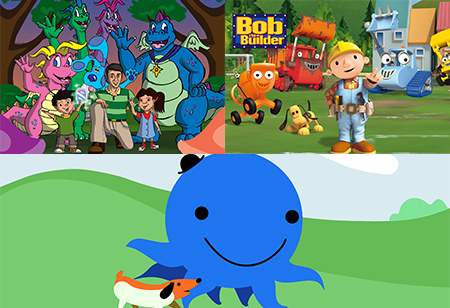Re-living Nostalgia: Bob the Builder, Oswald, and More
The children's programs we grew up watching have a unique quality. They influenced our early perspective, gave us consolation during our formative years, and imparted valuable lessons through vibrant characters. Shows like "Bob the Builder," "Oswald," and others among them have transformed from simple entertainment into childhood relics with deep emotional resonance for millennials and Gen Z adults decades later.
Beyond mere amusement, the resurgence of interest in classic children's programming is about rediscovering aspects of ourselves that we are often forced to suppress as adults. These programs provide a moment of relief—an opportunity to rediscover the innocence and hope of youth in an increasingly complicated and uncertain world.
"When adults go back to the media of their youth, they're frequently looking for solace in stressful or transitional situations. These shows represent a period when problems were solvable within a 22-minute episode, and the world made sense in ways it sometimes doesn't as an adult,” says Dr. Melissa Thompson, a psychologist who focuses on media consumption trends.
Bob the Builder: More than Construction
There aren't many children's programs that demonstrate constructive problem-solving and upbeat messages like "Bob the Builder." Bob, his talking construction vehicles, and the now-famous phrase "Can we fix it?" were first introduced to viewers of this British animated series in 1999. "Yes, we can."
Bob the Builder stood out for its direct approach to issues rather than its intricate narrative or high caliber of animation. In every episode, there was a problem in the Bobsville community that needed to be solved with cooperation, forethought, and tenacity. Values like teamwork, accountability, and the satisfaction of a job well done were subtly ingrained in the audience by the show.
Bob's upbeat attitude toward challenges resonates differently with many adults rewatching the series now than it did when they were younger. From a straightforward children's slogan, his catchphrase has developed into a personal motto for overcoming obstacles in life and a linguistic abbreviation for resilience that many people employ in their professional lives.
Oswald: Finding Peace in the Blue Beyond
Bob the Builder imparted useful skills, but "Oswald" offered something just as worthwhile: emotional intelligence and mindfulness before they were accepted as social norms. Beginning in 2001, the show followed the daily exploits of a blue octopus named Oswald and his dog, Weenie, in the made-up city of Big City.
Oswald stood out for its slow tempo and focus on kindness. There were only commonplace situations that required empathy, understanding, and consideration—no villains to defeat or catastrophic events to avoid. The show's unique piano-driven score by Evan Lurie produced a calm ambiance that is unusual in children's television.
"Oswald represented a radical departure from the frenetic energy of many children's shows," critic Jordan Chen writes. “It demonstrated to kids—and, perhaps more significantly, to parents—that engaging entertainment doesn't have to be loud or fast-paced. Slowing down and enjoying the little things has its benefits.” Oswald's easygoing lifestyle seems like a lost art that needs to be rediscovery for adults navigating the intricacies of contemporary life.
Supporting Cast: Arthur to Dragon Tales
Beyond these two programs, a whole ecosystem of children's programming from the late 1990s and early 2000s has been swept up in the nostalgia renaissance. Each show contributed something different to the emotional growth of a generation: "Dragon Tales," which focused on conquering fears; "Arthur," which addressed difficult social issues with amazing nuance; and "Clifford the Big Red Dog," which embraced differences as strengths.
In addition to offering children entertainment, these programs helped them process their emotions, navigate social interactions, and develop core values that many of them carried into adulthood. They served as early empathy exercises by introducing young viewers to perspectives and situations that were different from their own.
Digital Archaeology: Preserving Childhood Memory
The internet has altered how we perceive nostalgia. What once required dusty VHS tapes or serendipitous cable reruns is now on demand. This accessibility has democratized nostalgia, allowing people to create their own emotional journeys using the content that shaped them.
Online forums devoted to particular series have become places where viewers can exchange recollections, offer adult commentary on episodes, and sometimes even get in touch with the show creators who influenced their early years. These distant gathering spots serve as cultural repositories, conserving not just the stories themselves but also the collective experience of growing up with them.
This neural connection explains why platforms such as YouTube have received millions of views on uploaded episodes of these shows, as well as why streaming services are increasingly including classic children's programming in their catalogs.
Looking Forward Through the Lens of the Past
As we revive and reexamine our childhood shows, an intriguing question arises: what will children who watch today's programming remember fondly in twenty years? Will characters like Bluey or the PAW Patrol have the same emotional resonance with future adults?
The continuity between generations indicates that they will. The basic needs these shows address—the need for belonging, the value of kindness, the need for perseverance, and the consolation of knowing that obstacles can be overcome—remain constant even as animation techniques and storytelling become more complex.
We are rediscovering timeless truths about the human condition by reexamining "Bob the Builder," "Oswald," and their contemporaries. The straightforwardness of these tales from childhood frequently aids in our comprehension of the most crucial aspects of our complicated adult lives. Perhaps this is why, when confronted with adult challenges, we still ask ourselves, "Can we fix it?" And somewhere inside, a chorus is still saying, "Yes, we can."
🍪 Do you like Cookies?
We use cookies to ensure you get the best experience on our website. Read more...






